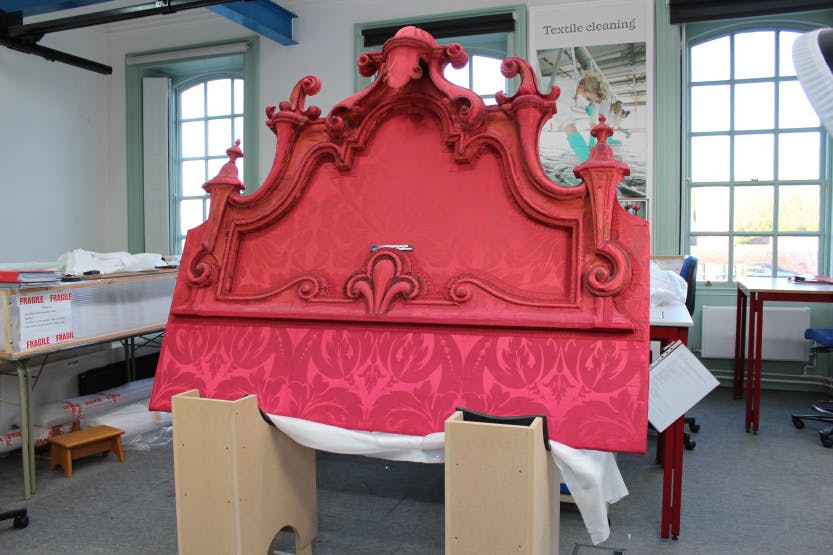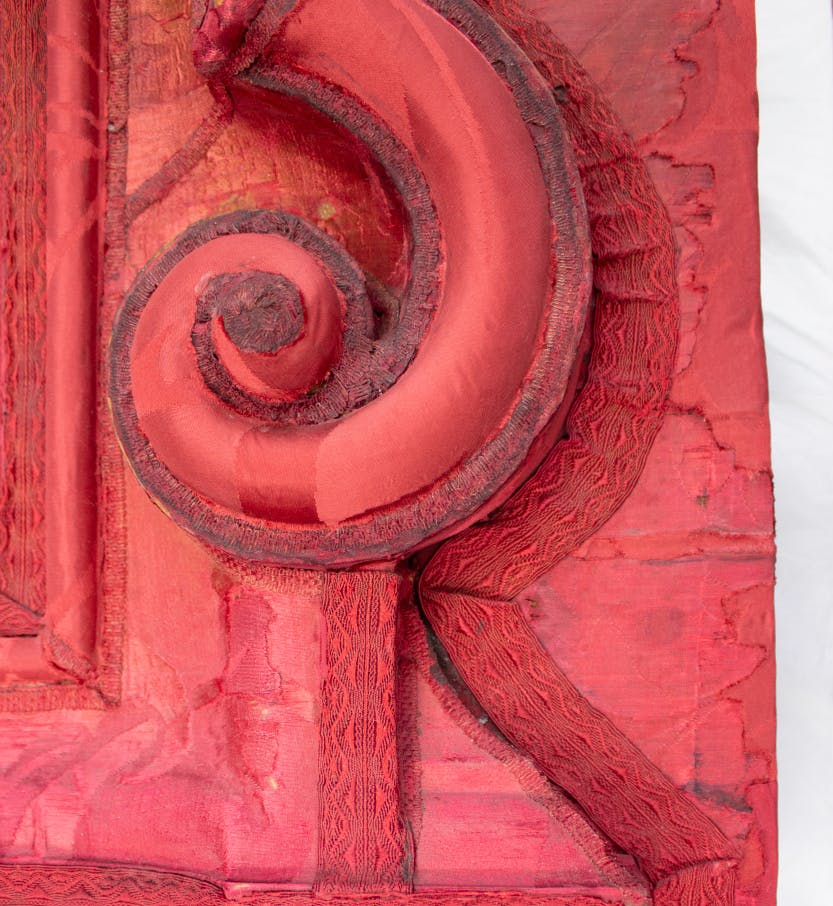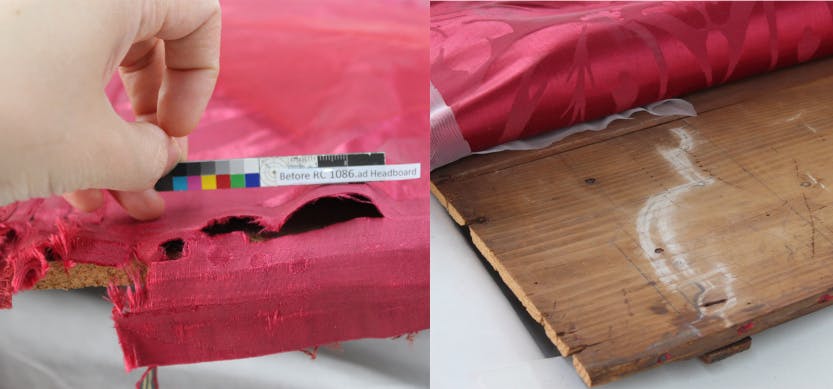Conservation of an 18th century headboard: Secrets of a State Bed
Date: 13 March 2020
Author:
Viola Nicastro
Conservator Viola Nicastro explains the process of conserving the headboard of Queen Caroline's State bed, and reveals more of the secrets of this amazing item.
A status symbol
The headboard is a rather impressive part of the bed, embodying the status of its owner. Constructed of laminated pine sections expertly carved to form an ornate scrolling shape, it is covered with silk damask and embellished with silk braids, adhered with animal glue.
The design culminates with the Prince of Wales' feathers at the top, revealing the status of who was it made for, no less than the prince and princess of Wales themselves, the future King George II and Queen Caroline.
Conserving history
The most exciting part of a project for me is when I start looking at an object. It is a bit like going on a blind date, where you don't quite know what to expect. If only the headboard could tell me something more about its history! When I started looking at it carefully, it was as if it was listening to my thoughts, as the object itself gradually started to give me clues, unravelling its secrets.
At a first glance, the headboard appears in good condition, with its lustrous silk damask shining in the middle. However, if you take a closer look you notice that not all the damask is the same and that the condition of it varies significantly. Given the status of this object and the fact that it has been on display for over 300 years, it is not surprising that the damask, exposed to light and dust, has become fragile. Look at the image below, can you spot it? The scroll is covered with a well-preserved red damask, while the red silk damask with tones of pink next to it is fragile. A little patch of damask is also visible at the left of the central braid.
A sneak peek into a craftsman's workshop: the lower panel
The only surviving part of the original silk damask in full width is on the lower panel, which remained protected from light for over 300 years by hiding behind the six mattresses. For this reason, it was quite well preserved overall, but with splits along the edges where it was attached to the wood by small nails.
Conservation treatment was very much needed here to stabilise the silk and prevent loss. The damask was given a full backing, to which we stabilised the weak damask by stitching to it. This means securing the damaged area with lines of evenly spaced stitching called laid couching.
As we started releasing the damask from the bottom to accommodate our support, something extraordinary was revealed: pencil and chalk lines forming the design of the volutes, or spiral-shaped scrolls. The measurements and design correspond to the sculptured edge above. This lower panel was clearly used as a sketch book by the craftsman!
A "not so new" braid
Some of you might have heard about the devastating fire that happened at Hampton Court Palace in 1986. This unfortunate event meant that our predecessors had to prioritise the conservation of the objects affected by it, so that the restoration of the bed that was well under way since 1984 was never completed. At that point, the central panel of the headboard was given a new damask, woven in silk to reproduce the original. Originally, a silk braid would have framed the edges along the perimeter. Our colleagues had it ready but never had the chance to apply it.
Luckily, they left really good documentation behind and the braid was still in our studio, so all we had to do, was to work out how to reapply it. We researched an adhesive that didn't dry too quickly so we had the time to make all of the pleats necessary to go around the curves, that was strong enough to keep the braid in place but most importantly that it would be conservation grade and reversible.
Once we found the adhesive that ticked all of the boxes, we trialled and practiced the technique, and we re-applied the braid along the perimeter of the central panel.
This content is hosted on YouTube
This content may be using cookies and other technologies for which we need your consent before loading. To view the content, you need to enable cookies for "Targeting Cookies & Other Technologies".
Manage CookiesHave a look at the time-lapse video to see how we did it and see yourself what a difference a finished edge can make. This video also includes the stitching treatment of the lower panel, a bit of cleaning with gels, the re-adhesion of loose parts of the damask and more! It will give you an insight of what it takes to conserve such a beautiful object.
By Viola Nicastro
Senior Textile Conservator
More from our blog

Six mattresses for a Queen: Secrets of a State Bed
30 January 2020
As conservation work continues on Queen Caroline's State bed, Conservator Beatrice Farmer shares discoveries on the lavish silk-covered mattresses, including one that appears to be an impostor. The bed is part of the Royal Collection, and can usually be found on display at Hampton Court Palace.

Princess Margaret and Jose 'Pitoy' Moreno
03 October 2025
PhD researcher Jamie Ostman traces a fascinating story of global royal style, Filipino history and national identity.

The Dress Codes of Diana, Princess of Wales
08 August 2025
Collections Curator Matthew Storey traces Diana, Princess of Wales's style journey through the words of four of her designers, and the extraordinary pieces in the Royal Ceremonial Dress Collection.



